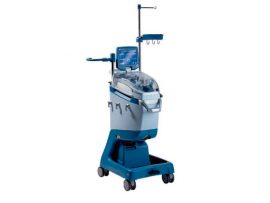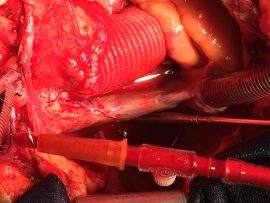Abstract Background There remains significant variability in the use of intraoperative mechanical circulatory support in lung transplantation. This report details our outcomes using elective cardiopulmonary bypass (CPB) in lung transplantation...
WeiterlesenAbstract Background Congenital heart disease is the most common neonatal congenital condition. Surgery is often necessary. Patients with congenital heart disease are potentially exposed to red cell transfusion preoperatively, intraoperatively..
WeiterlesenAbstract There is no consensus on the ideal sweep gas flow volume for achieving targeted blood partial gas pressures during cardiopulmonary bypass (CPB). The sweep gas flow rate is one..
WeiterlesenAbstract Background: The sustained renal effects of exposure to cardiopulmonary bypass are unknown. This study aimed to test whether cardiopulmonary bypass (CPB) is associated with sustained renal tissue hypoxia and..
WeiterlesenAbstract Objective Hemolysis is a complication in surgical procedures requiring cardiopulmonary bypass (CPB). The primary aim of this study was to evaluate the effectiveness of the point-of-care device Hemcheck Helge..
WeiterlesenAbstract Background Although goal-directed perfusion (GDP) during cardiopulmonary bypass (CPB) has been discussed extensively in adult studies, no pediatric indexed oxygen delivery (Do2i) thresholds are universally accepted, and no pediatric..
WeiterlesenAbstract Background Continuous blood gas monitoring (CBGM) during cardiopulmonary bypass (CPB) is essential for maintaining optimal patient outcomes, enabling rapid responses to critical fluctuations in blood gas parameters. This non-inferiority..
WeiterlesenAbstract Background The objective of this study was to evaluate mean cerebral blood flow velocity, gaseous microemboli (GME) counts, regional cerebral oxygen saturation (rSO2), and clinical outcomes using multimodality neuromonitoring..
WeiterlesenAbstract Over 10% of children develop thrombosis after cardiac surgery for congenital heart disease. Children with a single ventricle physiology have the highest risk of thrombosis associated with increased length..
WeiterlesenAbstract Objectives: Previous studies have demonstrated an association between transfusion and increased organ dysfunction. We sought to determine the association between transfusion of blood components (red blood cell [RBC], plasma, platelet,..
WeiterlesenAbstract Objectives To investigate copeptin levels during the full perioperative course in open, adult cardiac surgery with cardiopulmonary bypass (CPB). Design Prospective cohort study. Setting A single-center study conducted in..
WeiterlesenAbstract Background: del Nido cardioplegia (dNC) solution is widely used in pediatric and congenital cardiac surgery. In 2014, Cincinnati Children’s Hospital Medical Center (CCHMC) changed from Mee cardioplegic solution to..
WeiterlesenAbstract Cardioplegic arrest and cardiopulmonary bypass (CP/CPB) are known to engender microvascular dysfunction in patients undergoing cardiac surgery. These effects are significantly varied by patient comorbidities including diabetes and hypertension...
WeiterlesenAbstract Following cardiopulmonary bypass (CPB) surgery, patients may experience vasoplegic or vasogenic shock syndrome. This condition has a variable incidence, reaching up to 44% in high-risk patients, with mortality rates..
WeiterlesenAbstract Background Venoarterial extracorporeal membrane oxygenation (VA ECMO) is a critical therapeutic intervention that is commonly used in the management of paediatric patients with congenital heart disease (CHD). This procedure..
WeiterlesenAbstract Background The optimal fluid management strategy for patients undergoing on-pump cardiac surgery was controversial regarding the fluid types. This study aimed to compare the impact of hydroxyethyl starch (HES)..
WeiterlesenAbstract Background Pericardiectomy is the curative treatment for constrictive pericarditis, yet postoperative low cardiac output syndrome (LCOS) may occur. The application of venoarterial extracorporeal membrane oxygenation (VA-ECMO) in post-pericardiectomy refractory..
WeiterlesenAbstract Cardiopulmonary bypass (CPB) is widely used in cardiac operations. However, it remains unclear whether a CPB circuit, which is mainly made of plastics, can release micronanoplastics (MNPs) into the..
WeiterlesenAbstract Background and Objective: Effective cerebral perfusion monitoring is essential in aortic arch surgery, particularly when employing the Kazui technique under moderate hypothermia. Near-infrared spectroscopy (NIRS) provides real-time regional oxygen..
WeiterlesenAbstract Purpose Postoperative Delirium (POD) has an incidence of up to 65% in older patients undergoing cardiac surgery. We aimed to develop two dynamic nomograms to predict the risk of..
WeiterlesenAbstract Background Current adult cardiac surgery guidelines recommend against the routine use of prophylactic intravenous corticosteroids during cardiopulmonary bypass (CPB) due to concerns about myocardial injury, despite their potential to..
WeiterlesenAbstract Purpose Cardiac surgery requiring cardiopulmonary bypass (CPB) is frequently complicated by excessive bleeding because of coagulopathy. Contact of blood with the CPB circuit is a major contributor. While several..
WeiterlesenAbstract Introduction: Risk prevention protocols related to patient care have been developed to reduce the incidence of adverse events in health care services. Cardiopulmonary bypass (CPB) can trigger several complications,..
WeiterlesenAbstract OBJECTIVES To assess the effects of unilateral versus bilateral antegrade cerebral perfusion (u-ACP vs. b-ACP) on postoperative complications and mid-term follow-up results in Asian patients with acute type A..
WeiterlesenAbstract Importance Children with congenital heart defects who undergo cardiopulmonary bypass (CPB) surgery are at risk for delayed or impaired neurodevelopmental outcomes. Nitric oxide (NO) added to the CPB oxygenator may..
WeiterlesenAbstract Chronic kidney disease (CKD) affects 50% of patients with heart failure. The pathophysiology of CKD in heart failure is proposed to be driven by macrocirculatory hemodynamic changes, including reduced..
WeiterlesenAbstract OBJECTIVES A best evidence topic was written according to a structured protocol described in ICVTS. The question addressed was ‘In patients with vasoplegic syndrome following cardiac surgery with cardiopulmonary bypass,..
WeiterlesenAbstract Background This study investigates the impact of nursing interventions, guided by behavior change theory, on the recovery of cardiac function and quality of life in patients undergoing cardiac surgery..
WeiterlesenAbstract Background: Postoperative delirium (POD) is a severe complication following cardiac surgery and is associated with increased morbidity and mortality. The impact of intra- and early postoperative factors on the..
WeiterlesenAbstract OBJECTIVES A best evidence topic was written according to a structured protocol described in ICVTS. The question addressed was ‘In patients with vasoplegic syndrome following cardiac surgery with cardiopulmonary bypass,..
Weiterlesen





















